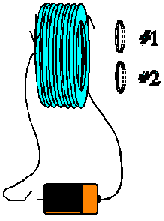
Teaching Physics with the Physics Suite
Home | Action Research Kit| Sample Problems | Resources | Product Information
Problems Sorted by Type | Problems Sorted by Subject | Problems Sorted by Chapter in UP
 |
Teaching Physics with the Physics Suite
Home | Action Research Kit| Sample Problems | Resources | Product Information |
Problems Sorted by Type | Problems Sorted by Subject | Problems Sorted by Chapter in UP |
| In the picture at the right is shown a solenoid and two loops. When the switch is closed, the solenoid carries a current in the direction indicated. The planes of the loops are parallel to the planes of the loops of the solenoid. The picture is drawn so that the part of the loop closest to you is drawn as solid, while that part farthest away is drawn dashed. Loop #1 consists of a single turn of resistive wire that has a resistance per unit length of l. Loop #2 consists of N turns of the same wire. Each loop is a circle of radius r
|
 |
where g is a constant. Is there a current flow induced in the loops? If there is a current, indicate the direction
Not finding what you wanted? Check the Site Map for more information.
Page last modified November 5, 2002: MG17